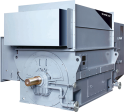On large pumps, significant energy savings can be realized by replacing a fixed speed motor and old flow control technology with a variable speed motor.
This example is a pump supplying water and driven by a fixed speed induction motor. The water flow is controlled with a diaphragm operated control valve controlled by a signal from the process control system (PLC or DCS).
If less flow is required the valve is partially closed, which reduces the flow to the desired value and increases the pump pressure at the same pump speed. This is called flow throttling, and the pressure drop across the valve causes energy to be lost. Also since the pump is working against a higher pressure, more energy is required from the motor.
The situation is much improved if a variable speed motor, supplied by a variable frequency drive (VFD) is used. The control valve is no longer required since the flow is varied by changing the motor speed. The VFD is supplied by 50 or 60 Hertz three-phase power, and creates a three-phase output of any desired frequency. The motor changes speed to match the frequency supplied to it, and drives the pump at this speed, which produces the desired flow.

To reduce the flow there is no throttling and the pump supplies the flow against a much lower pressure, so the motor power required is much less. This represents a significant energy savings, especially if the reduced flow continues for any extended period.








